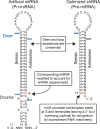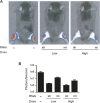Minimizing variables among hairpin-based RNAi vectors reveals the potency of shRNAs
- PMID: 18697922
- PMCID: PMC2525944
- DOI: 10.1261/rna.1062908
Minimizing variables among hairpin-based RNAi vectors reveals the potency of shRNAs
Abstract
RNA interference (RNAi) is a cellular process regulating gene expression and participating in innate defense in many organisms. RNAi has also been utilized as a tool to query gene function and is being developed as a therapeutic strategy for several diseases. Synthetic small interfering (siRNAs) or expressed stem-loop RNAs (short-hairpin RNAs [shRNAs] or artificial microRNAs [miRNAs]) have been delivered to cultured cells and organisms to inhibit expression of a variety of genes. A persistent question in the field, however, is which RNAi expression system is most suitable for distinct applications. To date, shRNA- and artificial miRNA-based strategies have been compared with conflicting results. In prior comparisons, sequences required for efficient RNAi processing and loading of the intended antisense strand into the RNAi-induced silencing complex (RISC) were not considered. We therefore revisited the shRNA-miRNA comparison question. Initially, we developed an improved artificial miRNA vector and confirmed the optimal shRNA configuration by altering structural features of these RNAi substrates. Subsequently, we engineered and compared shRNA- and miRNA-based RNAi expression vectors that would be processed to yield similar siRNAs that exhibit comparable strand biasing. Our results demonstrate that when comparison variables are minimized, the shRNAs tested were more potent than the artificial miRNAs in mediating gene silencing independent of target sequence and experimental setting (in vitro and in vivo). In addition, we show that shRNAs are expressed at considerably higher levels relative to artificial miRNAs, thus providing mechanistic insight to explain their increased potency.
Figures







Similar articles
-
pSM155 and pSM30 vectors for miRNA and shRNA expression.Methods Mol Biol. 2009;487:205-19. doi: 10.1007/978-1-60327-547-7_10. Methods Mol Biol. 2009. PMID: 19301649
-
Artificial miRNAs as therapeutic tools: Challenges and opportunities.Wiley Interdiscip Rev RNA. 2021 Jul;12(4):e1640. doi: 10.1002/wrna.1640. Epub 2021 Jan 1. Wiley Interdiscip Rev RNA. 2021. PMID: 33386705 Review.
-
A quick and efficient approach for gene silencing by using triple putative microRNA-based short hairpin RNAs.Mol Cell Biochem. 2009 Mar;323(1-2):81-9. doi: 10.1007/s11010-008-9966-3. Epub 2008 Nov 27. Mol Cell Biochem. 2009. PMID: 19037714
-
miRNA and shRNA expression vectors based on mRNA and miRNA processing.Methods Mol Biol. 2013;936:195-207. doi: 10.1007/978-1-62703-083-0_16. Methods Mol Biol. 2013. PMID: 23007510
-
Recombinant AAV as a platform for translating the therapeutic potential of RNA interference.Mol Ther. 2014 Apr;22(4):692-701. doi: 10.1038/mt.2013.285. Epub 2013 Dec 19. Mol Ther. 2014. PMID: 24352214 Free PMC article. Review.
Cited by
-
Evaluation of Mono- and Bi-Functional GLOBE-Based Vectors for Therapy of β-Thalassemia by HBBAS3 Gene Addition and Mutation-Specific RNA Interference.Cells. 2023 Dec 15;12(24):2848. doi: 10.3390/cells12242848. Cells. 2023. PMID: 38132168 Free PMC article.
-
Blocking sense-strand activity improves potency, safety and specificity of anti-hepatitis B virus short hairpin RNA.EMBO Mol Med. 2016 Sep 1;8(9):1082-98. doi: 10.15252/emmm.201506172. Print 2016 Sep. EMBO Mol Med. 2016. PMID: 27473329 Free PMC article.
-
The transcription factor ATF4 promotes skeletal myofiber atrophy during fasting.Mol Endocrinol. 2010 Apr;24(4):790-9. doi: 10.1210/me.2009-0345. Epub 2010 Mar 2. Mol Endocrinol. 2010. PMID: 20197309 Free PMC article.
-
Current prospects for RNA interference-based therapies.Nat Rev Genet. 2011 May;12(5):329-40. doi: 10.1038/nrg2968. Nat Rev Genet. 2011. PMID: 21499294 Free PMC article. Review.
-
Artificial microRNAs as siRNA shuttles: improved safety as compared to shRNAs in vitro and in vivo.Mol Ther. 2009 Jan;17(1):169-75. doi: 10.1038/mt.2008.231. Epub 2008 Nov 11. Mol Ther. 2009. PMID: 19002161 Free PMC article.
References
-
- Birmingham A., Anderson E.M., Reynolds A., Ilsley-Tyree D., Leake D., Fedorov Y., Baskerville S., Maksimova E., Robinson K., Karpilow J., et al. 3′ UTR seed matches, but not overall identity, are associated with RNAi off-targets. Nat. Methods. 2006;3:199–204. - PubMed
-
- Bridge A.J., Pebernard S., Ducraux A., Nicoulaz A.L., Iggo R. Induction of an interferon response by RNAi vectors in mammalian cells. Nat. Genet. 2003;34:263–264. - PubMed
Publication types
MeSH terms
Substances
Grants and funding
LinkOut - more resources
Full Text Sources
Other Literature Sources
